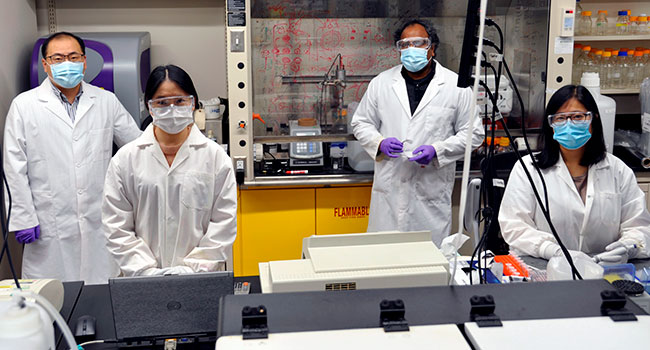In 2017, Hyo-Jick Choi and his engineering research team released a study outlining a breathable surgical mask that just doesn’t catch pathogens from entering the respiratory system; it kills them.
Choi, a professor in the Faculty of Engineering who runs the Sustainable Engineering and Drug Delivery Design (SEƎD) lab, developed the idea of an antiviral, antibacterial filter for a face mask that uses salt recrystallization to inactivate airborne pathogens while he was researching oral vaccines a few years earlier.
One of the problems with an oral vaccine is that, to ensure storage stability, the solution is mixed with sugar before the water is removed and it is dried out. Choi explained that during the drying process, the major technical challenge was that the sugar crystallizes under some specific drying conditions and destroys the vaccine.
“I wanted to try to figure out how to prevent the crystallization,” said Choi.
If there is a process that destroys the vaccine, Choi said it will also destroy the virus, because the virus is the same structurally as an inactivated virus vaccine.
That’s when he thought about the mask.
“I used salt instead because sugar, depending on drying conditions, sometimes crystallizes, but sometimes it remains in an amorphous, glassy state, which the vaccine or virus would be stable in,” he said.
A dose of COVID-19 reality by Pat Murphy
He coated polypropylene fabric filters with a salt formulation and showed that it inactivates the influenza virus and, most recently, bacteria.
For the next step in the project development, Choi’s lab will focus on manufacturing prototype salt-coated masks and respirators, or an inactivating salt-coated filter that is easy to produce and is reusable without fear of decontamination, enabling increased protection of front-line workers.
In trying to commercialize the technology, Choi said he still has some barriers to clear. The first is government certification.
Choi explained the conventional mask is very simple in structure and includes filters with specific dimensions, stacked in three or four layers.
However, even though they just have to functionalize one or two of the layers, Choi said while the mask doesn’t require clinical trials, the modified filters change the design of the traditional face mask enough that it is not the same.
“The performance cannot be changed. We are not just talking about the pathogen inactivation. There are many guidelines that we have to satisfy – materials safety, environmental stability, reusability, breathability, filtration efficiency – at the same time as pathogen inactivation.”
In the meantime, Choi said he’s going to continue to refine the mask in a lab setting. However, to make a real prototype to industry standards, he needs mask manufacturing equipment and filter testing equipment.
“After the outbreak of COVID-19, many people asked when the mask will be made available,” he said. “It’s going to take time.”
“We’re not talking about toys; it is the medical device that is critical to the respiratory system. So we have to consider everything,” he said. “However, I’m optimistic that we can get this to market by the end of next year. Also, we will be able to complete new technologies under development in a few months that can contribute to containing COVID-19.”
| By Michael Brown
This article was submitted by the University of Alberta’s online publication Folio, a Troy Media content provider partner.
The views, opinions and positions expressed by columnists and contributors are the author’s alone. They do not inherently or expressly reflect the views, opinions and/or positions of our publication.



